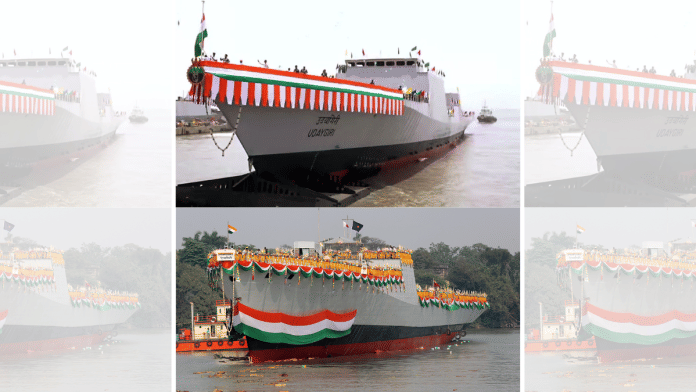New Delhi: For the first time, two indigenously built major surface combatants—INS Udaygiri and INS Himgiri, constructed at separate shipyards—will be commissioned simultaneously into the Navy’s fleet at Visakhapatnam on 26 August.
Both stealth frigates belong to the Nilgiri class or Project 17 Alpha (P-17A), under which the lead vessel, INS Nilgiri, was commissioned earlier this year in the presence of Prime Minister Narendra Modi. Two other combatants, INS Surat and INS Vagsheer, all featuring a high degree of indigenous content, were also commissioned at the same time.
Sources in the Navy said that at least four more domestically built P-17A frigates—Taragiri, Mahendragiri, Dunagiri and Vindhyagiri—are expected to enter service over the next year, and will help the Navy expand its operational reach in the Indian Ocean Region (IOR).
According to a statement from the defence ministry, INS Udaygiri, the second ship of the Project 17A stealth frigates, was built by Mumbai-based Mazagon Dock Shipbuilders Limited (MDL) in Mumbai, while INS Himgiri is the first of the class to be constructed by Kolkata-based Garden Reach Shipbuilders & Engineers (GRSE).
With a budget of Rs 45,000 crore, the P-17A frigates are among the first in India to be built using “integrated modular construction,” where hundreds of pre-outfitted blocks are assembled, reducing build time and improving quality control.
Displacing over 6,700 tonnes, these two frigates—with indigenous content of at least 75 percent—are about five percent larger than their Shivalik-class predecessors, yet employ a sleeker hull form with a reduced radar cross-section.
Sources explained that the two frigates incorporate features such as an enclosed mooring deck, a low infrared signature and a deck rail system that allows safe movement of crew and equipment. This design eliminates the need for guardrails and, in turn, boosts the warships’ stealth characteristics.
“The superstructure of these frigates uses composite materials with radar-absorbent coatings to reduce the radar cross-section. The enclosed decks and flush-mounted weapons minimise signatures, while the exhausts are fitted with infrared suppression systems to cut heat emissions. Collectively, these measures significantly lower the ships’ radar, infrared and acoustic profiles,” a source said.
The frigates are powered by a Combined Diesel and Gas (CODAG) propulsion system comprising two diesel engines and two gas turbines, all licence-produced in India.
Controlled through an Integrated Platform Management System (IPMS), the arrangement delivers speeds in excess of 28 knots and an endurance of around 5,500 nautical miles, permitting sustained blue-water operations.
Beneath the waterline, the frigates carry the Hull Mounted Sonar Advanced – Next Generation (HUMSA-NG) sonar developed by state-owned Bharat Electronics Limited (BEL), which detects submarines and underwater threats by feeding early-warning data to anti-submarine weapons. All on-board sensors are integrated through the CMS-17A (combat management system), which acts as the ship’s central command hub, linking radar, sonar, weapons and communications to support rapid and coordinated decision-making.
For electronic warfare, the frigates are equipped with the Ajanta and Shakti suites, also developed locally by the Defence Research and Development Organisation (DRDO) and BEL. These systems pick up hostile radar and communication signals and can jam them, making it harder for the ship to be tracked or targeted.
On the defensive side, the frigates carry the Kavach chaff rocket launcher, designed by the Ordnance Factory Board. This anti-missile naval decoy system works by firing strips of metallic foil that create false radar images to confuse incoming missiles. Beneath the surface, they are fitted with the Maareech Torpedo Decoy System, another DRDO-BEL project, which releases acoustic decoys to mislead enemy torpedoes. Together, these systems give the ships a layered shield against both air and underwater threats.
Each frigate can accommodate around 225 personnel and embark ship borne helicopters for long-range anti-submarine and surveillance missions.
Weapons on board include the jointly developed Indo-Russian BrahMos supersonic missile, the Indo-Israeli Barak-8 naval long-range surface-to-air missile system (LRSAM), 76 mm naval guns produced under licence in India, and torpedoes for undersea warfare.
“These frigates give India a qualitative edge. Their extended range of 5,500 nautical miles and helicopter-borne anti-submarine warfare (ASW) capabilities allow patrols in distant waters and enable power projection alongside India’s aircraft carriers,” a source said.
By forming the core of the Eastern Fleet’s surface combatants, the P-17A frigates will operate alongside Delhi-class destroyers and Shivalik-class frigates and will also augment the Navy’s capacity to counter piracy and coercion.
(Edited by Shashank Kishan)
Also Read: Indian Navy modernisation riddled with binaries. Maritime strategy is directionless






